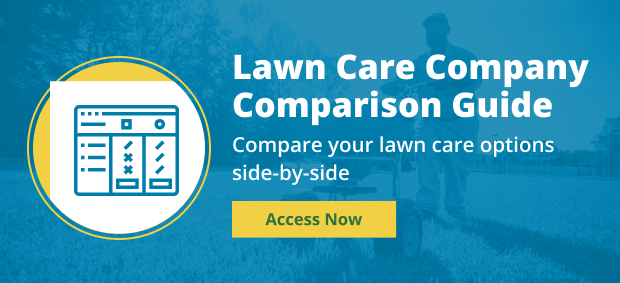How to Manage Multiple Types of Grass in the Same Lawn
You probably know there are multiple types of grasses out there across the country that grow in different home landscapes. There are cool-season and warm-season grasses that do best in northern and southern U.S. locations.
In a place like Central and Southern Maryland, we’re technically located between northern and southern extremes. We call this the transition zone, and this can make growing grass here challenging.
The best grass type for Maryland is tall fescue because it can withstand wear, heat, drought, and shade. It doesn’t mind the heat of summer too much and it also doesn’t go brown as easily as other warm-season grasses when temperatures dip below 50 degrees Fahrenheit.
Most of the grasses in home lawns here are tall fescue or tall fescue and a Kentucky bluegrass mix.
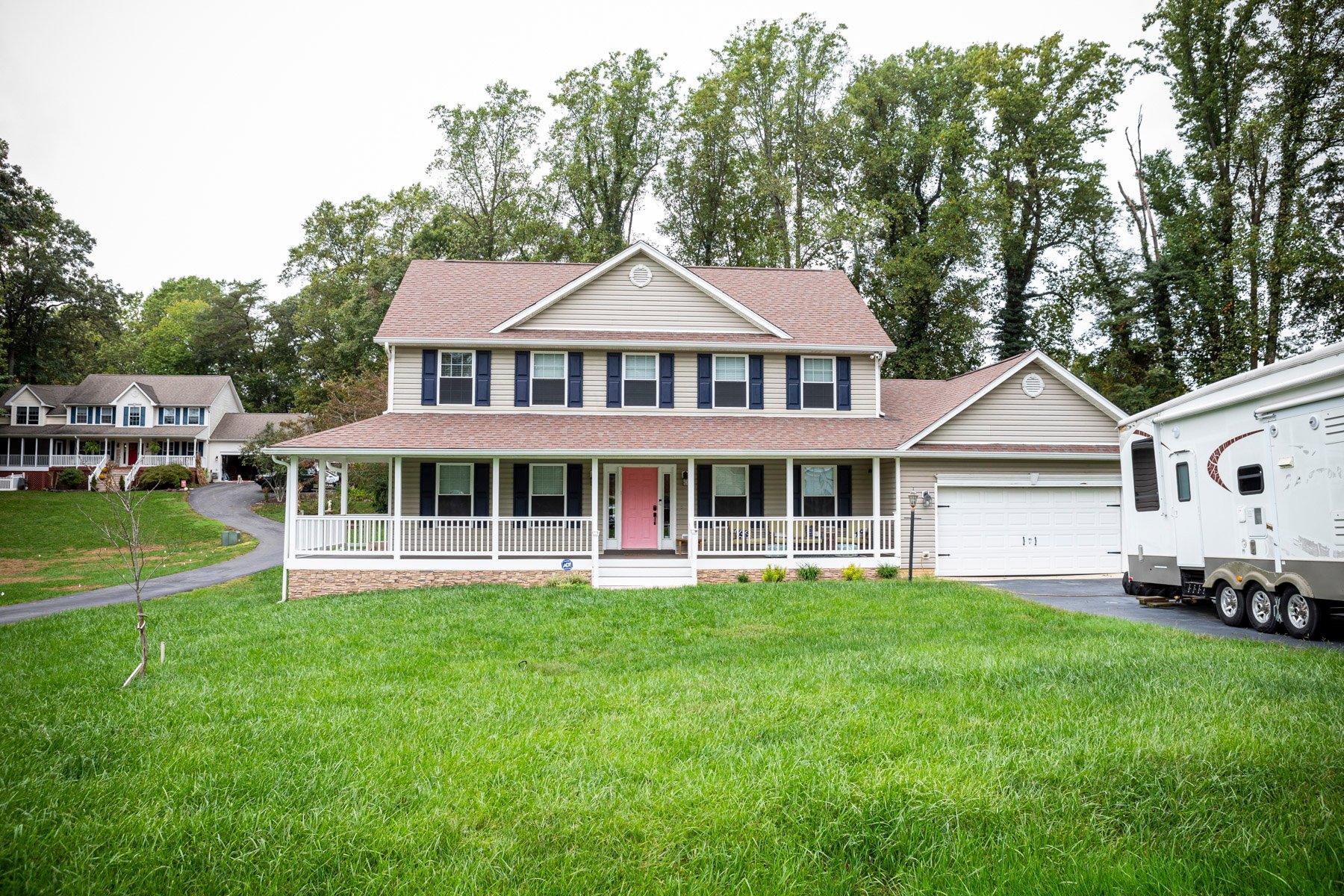 But occasionally you will have a lawn that has a mix of grasses. Maybe it’s different types of tall fescue or there's warm-season grass mixed in. You might even find front yards and backyards with two completely different grasses on the same property.
But occasionally you will have a lawn that has a mix of grasses. Maybe it’s different types of tall fescue or there's warm-season grass mixed in. You might even find front yards and backyards with two completely different grasses on the same property.
Managing different grass types in one lawn can certainly present some challenges. Let’s look at how to do this effectively and what you should expect from your lawn care professional when your lawn has different types of grass.
My Lawn Has Different Types of Grass – Help!
You might find yourself looking at patches of your lawn that just look a bit off.
And the options for what you’re looking at are actually numerous. If you’re seeing different grass types in one lawn, you’re potentially looking at:
- A finer blade of tall fescue like turf-type tall fescue and a thicker tall fescue.
- Perennial ryegrass could be mixed in with your tall fescue.
- A coarser blade of Kentucky bluegrass called Kentucky 31 could be mixed in with your tall fescue.
- You could have some grassy weeds mixed in with your tall fescue.
- Zoysiagrass could be growing in some parts of your yard.
All of these types of situations require different strategies to maximize good grass health.
Strategy #1: Fertilization
Depending on which situation above is the reason for your lawn with multiple grass types, each one will require a different strategy for nutrition.
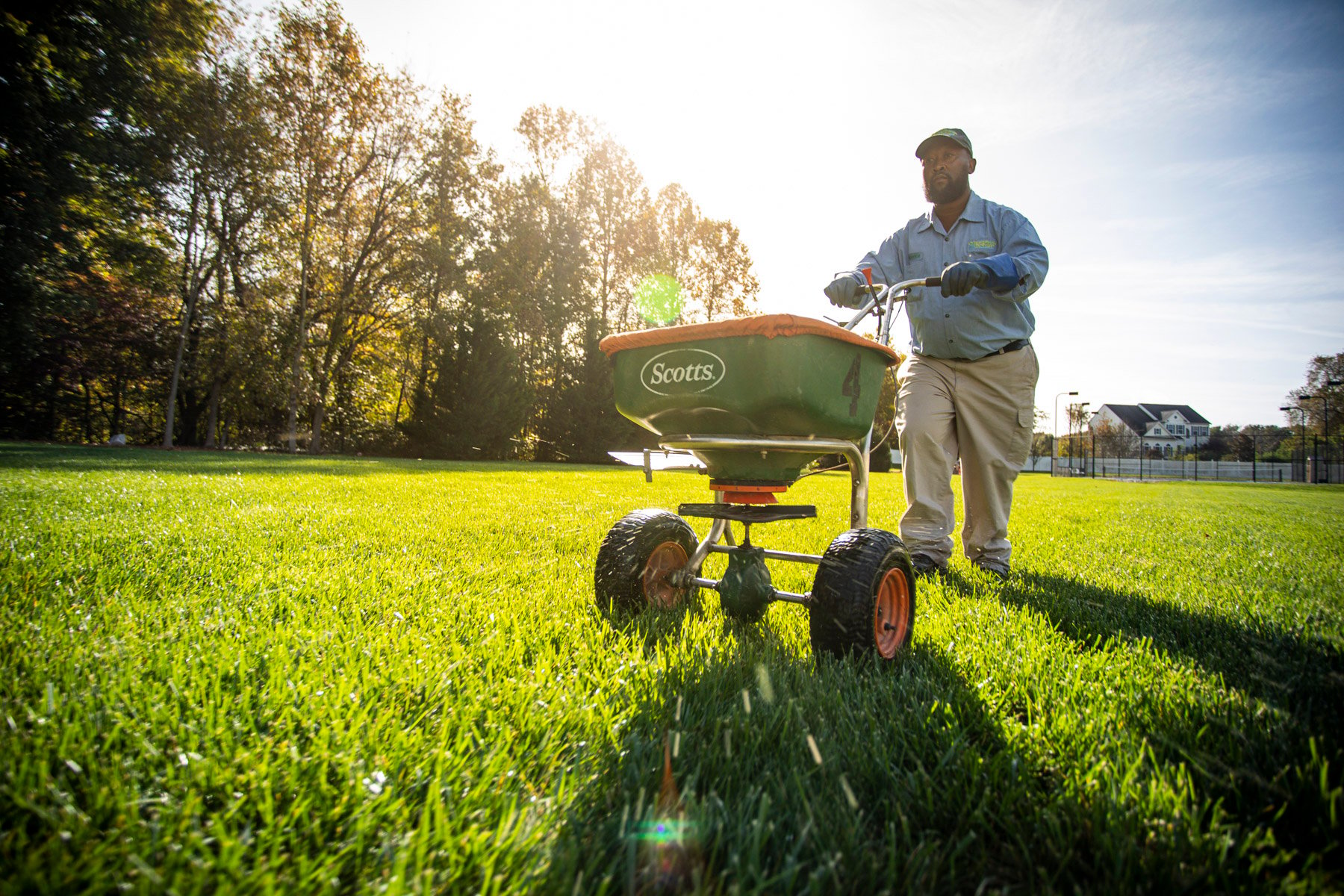 In addition to a specific fertilization program that matches the grass being treated, this will also require timing appropriate to the type of grass. If you have a lawn with tall fescue in the front yard and zoysiagrass in the backyard, this means you should receive two different treatments specific to each grass type for each section of your yard.
In addition to a specific fertilization program that matches the grass being treated, this will also require timing appropriate to the type of grass. If you have a lawn with tall fescue in the front yard and zoysiagrass in the backyard, this means you should receive two different treatments specific to each grass type for each section of your yard.
Strategy #2: Weed Control
Different types of grass in Maryland also have different weed pressures.
This requires more precise timing and targeted applications for herbicide treatments. This may mean some varied treatments in parts of your yard, depending on your grass situation.
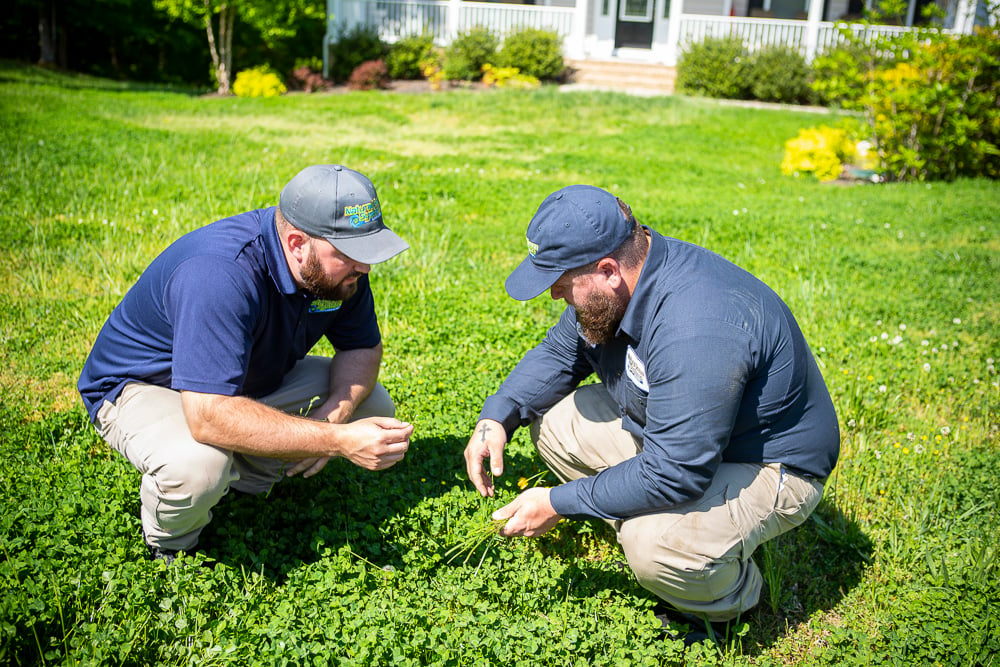 If your spotty grass issue is due to weeds, a proper weed control program targeting those grassy invaders that look like your lawn can control that problem and get your lawn looking back to one solid shade and texture.
If your spotty grass issue is due to weeds, a proper weed control program targeting those grassy invaders that look like your lawn can control that problem and get your lawn looking back to one solid shade and texture.
Strategy #3: Aeration and Overseeding
For all the situations above, as well as for lawns that don’t have problems with different grass types in one lawn, aeration and overseeding can improve appearance and health.
First, let’s talk about what aeration is. During aeration, we use a machine called an aeration to pull small soil plugs from your lawn. We deposte them back across the lawn. What this does is reduce compaction and allow the lawn to breathe, taking in nutrients, oxygen and water much better than before.
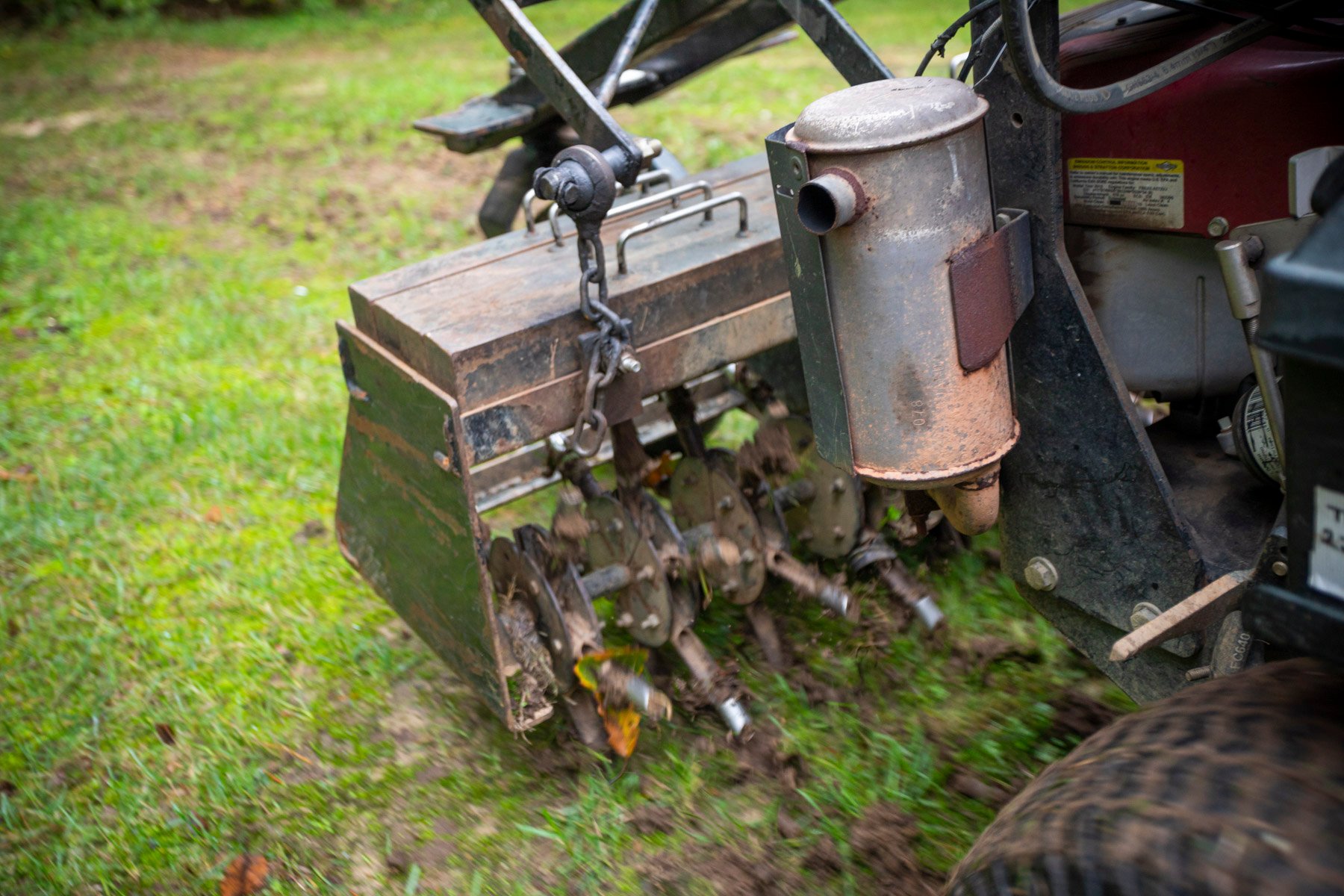 Compaction naturally happens over time due to foot traffic and rainfall, so it’s not something you can prevent. In fact, if you notice your fertilization strategy isn’t making a difference, this could be why. After aeration, your lawn will take in nutrients much better.
Compaction naturally happens over time due to foot traffic and rainfall, so it’s not something you can prevent. In fact, if you notice your fertilization strategy isn’t making a difference, this could be why. After aeration, your lawn will take in nutrients much better.
Then, while you have those holes in the soil, you can overseed with desirable grass to help fill in any bare spots or areas left blank from weeds. This will greatly improve the texture of your lawn and give it a nice, thick, even look, as well as a healthier appearance overall.
We Understand Growing Grass in Maryland
We know it can be hard managing a lawn with multiple grass types. But hopefully these explanations and strategies give you some idea as to why this is happening and what tips you can try to fix it.
If you look at your splotchy lawn and are still confused by what problem could be causing this mis-matched lawn pattern you have, give Natural Green Systems a call.
We can properly identify what is happening in your lawn and give you the right guidance and program to ensure your grass looks great.
Let’s get you that nice-looking lawn you crave. Natural Green Systems has all the grass-growing knowledge you need for your Central or Southern Maryland lawn. Get started today with a free quote. Together, we’ll customize a plan that gives your lawn the facelift it needs.
You probably know there are multiple types of grasses out there across the country that grow in different home landscapes. There are cool-season and warm-season grasses that do best in northern and southern U.S. locations.
In a place like Central and Southern Maryland, we’re technically located between northern and southern extremes. We call this the transition zone, and this can make growing grass here challenging.
The best grass type for Maryland is tall fescue because it can withstand wear, heat, drought, and shade. It doesn’t mind the heat of summer too much and it also doesn’t go brown as easily as other warm-season grasses when temperatures dip below 50 degrees Fahrenheit.
Most of the grasses in home lawns here are tall fescue or tall fescue and a Kentucky bluegrass mix.
 But occasionally you will have a lawn that has a mix of grasses. Maybe it’s different types of tall fescue or there's warm-season grass mixed in. You might even find front yards and backyards with two completely different grasses on the same property.
But occasionally you will have a lawn that has a mix of grasses. Maybe it’s different types of tall fescue or there's warm-season grass mixed in. You might even find front yards and backyards with two completely different grasses on the same property.
Managing different grass types in one lawn can certainly present some challenges. Let’s look at how to do this effectively and what you should expect from your lawn care professional when your lawn has different types of grass.
My Lawn Has Different Types of Grass – Help!
You might find yourself looking at patches of your lawn that just look a bit off.
And the options for what you’re looking at are actually numerous. If you’re seeing different grass types in one lawn, you’re potentially looking at:
- A finer blade of tall fescue like turf-type tall fescue and a thicker tall fescue.
- Perennial ryegrass could be mixed in with your tall fescue.
- A coarser blade of Kentucky bluegrass called Kentucky 31 could be mixed in with your tall fescue.
- You could have some grassy weeds mixed in with your tall fescue.
- Zoysiagrass could be growing in some parts of your yard.
All of these types of situations require different strategies to maximize good grass health.
Strategy #1: Fertilization
Depending on which situation above is the reason for your lawn with multiple grass types, each one will require a different strategy for nutrition.
 In addition to a specific fertilization program that matches the grass being treated, this will also require timing appropriate to the type of grass. If you have a lawn with tall fescue in the front yard and zoysiagrass in the backyard, this means you should receive two different treatments specific to each grass type for each section of your yard.
In addition to a specific fertilization program that matches the grass being treated, this will also require timing appropriate to the type of grass. If you have a lawn with tall fescue in the front yard and zoysiagrass in the backyard, this means you should receive two different treatments specific to each grass type for each section of your yard.
Strategy #2: Weed Control
Different types of grass in Maryland also have different weed pressures.
This requires more precise timing and targeted applications for herbicide treatments. This may mean some varied treatments in parts of your yard, depending on your grass situation.
 If your spotty grass issue is due to weeds, a proper weed control program targeting those grassy invaders that look like your lawn can control that problem and get your lawn looking back to one solid shade and texture.
If your spotty grass issue is due to weeds, a proper weed control program targeting those grassy invaders that look like your lawn can control that problem and get your lawn looking back to one solid shade and texture.
Strategy #3: Aeration and Overseeding
For all the situations above, as well as for lawns that don’t have problems with different grass types in one lawn, aeration and overseeding can improve appearance and health.
First, let’s talk about what aeration is. During aeration, we use a machine called an aeration to pull small soil plugs from your lawn. We deposte them back across the lawn. What this does is reduce compaction and allow the lawn to breathe, taking in nutrients, oxygen and water much better than before.
 Compaction naturally happens over time due to foot traffic and rainfall, so it’s not something you can prevent. In fact, if you notice your fertilization strategy isn’t making a difference, this could be why. After aeration, your lawn will take in nutrients much better.
Compaction naturally happens over time due to foot traffic and rainfall, so it’s not something you can prevent. In fact, if you notice your fertilization strategy isn’t making a difference, this could be why. After aeration, your lawn will take in nutrients much better.
Then, while you have those holes in the soil, you can overseed with desirable grass to help fill in any bare spots or areas left blank from weeds. This will greatly improve the texture of your lawn and give it a nice, thick, even look, as well as a healthier appearance overall.
We Understand Growing Grass in Maryland
We know it can be hard managing a lawn with multiple grass types. But hopefully these explanations and strategies give you some idea as to why this is happening and what tips you can try to fix it.
If you look at your splotchy lawn and are still confused by what problem could be causing this mis-matched lawn pattern you have, give Natural Green Systems a call.
We can properly identify what is happening in your lawn and give you the right guidance and program to ensure your grass looks great.
Let’s get you that nice-looking lawn you crave. Natural Green Systems has all the grass-growing knowledge you need for your Central or Southern Maryland lawn. Get started today with a free quote. Together, we’ll customize a plan that gives your lawn the facelift it needs.
Share This
Topics: Lawn Care


